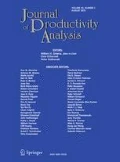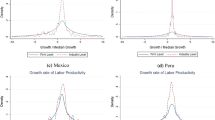Abstract
Sources of profit change for Telstra, Australia’s largest telecommunications firm, are examined. A new method allows for changes, in a firm’s profits to be broken down into separate effects due to productivity change, price changes, and growth in the firm’s size. This in turn allows us to calculate the distribution of the benefits of productivity improvements between consumers, labor, and shareholders. The results show that around half the benefits from Telstra’s productivity improvements from 1984 to 1994 were passed on to consumers in the form of real price reductions.




Similar content being viewed by others
Notes
This could be net or gross operating surplus. We will use gross operating surplus as our definition of “profit” in our empirical application (see Eq. 8)
The notation p t ≫ 0 N means each element of p is positive, while p t > 0 N means p t ≥ 0 N but p ≠ 0 N .
This gross-operating-surplus approach is consistent with national income accounting conventions. Gross operating surplus is equal to the value of outputs less the value of intermediate inputs less the value of labor input. Here we include labor as an intermediate input rather than a primary input, as firms can typically adjust their labor input even in the short run.
The usual axiomatic approach to index number theory regards the price and quantity vectors pertaining to two situtations to be compared as being completely exogenous vectors, whereas the economic approach to index number theory regards the two price vectors as being exogenous but the two quantity vectors are regarded as being determined endogenously as the solution to some sort of economic optimization problem.
Note that this is different from a national-accounting-type context, where labor is also treated as a primary input. It may be reasonable to make this assumption for a country, but for a firm which can easily vary its labor input in the short run, it seems more reasonable to treat labor as an intermediate good. Substitution between intermediate inputs and capital is still possible in the “long run,” and we will be using annual data where we observe changes in capital and the intermediate inputs in the same period. This particular assumption can be viewed as just being clear about the short-run variable inputs that are available to decision-makers in the firm each (arbitrarily short) period.
Alternative deflators to the consumer price index (CPI) could be considered. However, using a deflator for, e.g., telecommunications services and equipment in the current context would remove much or all of the price variability in which we are interested (as it would closely reflect the price movements in the industry, rather than just the general trend of overall inflation in the economy). Thus, we use the CPI as we want to capture contributions to profits from relative, or “real”, price changes; that is, the change in industry prices relative to overall economy-wide price changes measured by the CPI.
The BIE was absorbed by the Industry Commission in 1996 to form the Productivity Commission.
It is generally thought that output is not well measured in service industries, such as telecommunications, so it is possible that productivity growth is underestimated here. On the other hand, no adjustment has been made for changes in the quality of capital, and the estimated productivity growth includes capital-embodied technological change.
Of course, if there had actually been no productivity change, then Telstra’s investment decisions would have been different from those observed, for example. Our analysis is an ex post analysis of the observed data, so that by assuming “no change” of the other components, we are isolating contributions from each source in turn.
References
Bureau of Industry Economics (1995) International performance indicators—telecommunications 1995. Australian Government Publishing Service, Canberra
Balk BM (2003) On the relationship between gross-output and value-added based productivity measures: the importance of the domar factor. Centre for Applied Economic Research Working Paper 2003/05 (http://www.caer.unsw.edu.au/CAERpub.htm)
Boles de Boer D, Evans L (1996) The economic efficiency of telecommunications in a deregulated market: the case of New Zealand. Econ Record 72(216):2435
Canadian Radio-television and Telecommunications Commission (CRTC) (1997) Price cap regulation and related issues. Telecom Decision CRTC 979, Ottawa
Caves DW, Christensen LR, Diewert WE (1982) The economic theory of index numbers and the measurement of input, output, and productivity. Econometrica 50:1393–1414
Christensen LR, Jorgenson DW, Lau LJ (1973) Transcendental logarithmic production frontiers. Rev Econ Stat 55:28–45
Diewert WE (1974) Applications of duality theory. In: Intriligator MD, Kendrick DA (eds) Frontiers of quantitative economics vol. 2. North-Holland, Amsterdam
Diewert WE (1978) Superlative index numbers and consistency in aggregation. Econometrica 46:883–900
Diewert WE, Fox KJ (1999) Can Measurement error explain the productivity paradox?. Can J Econ 32:251–280
Diewert WE, Fox KJ (2001) The productivity paradox and mismeasurement of economic activity. In: Okina K, Inoue T (eds) Monetary policy in a world of knowledge-based growth, quality change, and uncertain measurement. Palgrave
Diewert WE, Morrison CJ (1986). Adjusting output and productivity indexes for changes in the terms of trade. Econ J 96:659–679
Diewert WE, Lawrence D (2000) Progress in measuring the price and quantity of capital. In: Lau LJ (ed) Econometrics, vol. 2. Econometrics and the cost of capital: essays in honour of dale W. Jorgenson. MIT Press, Cambridge and London, pp 273–326
Fox KJ, Kohli U (1998) GDP growth, terms of trade effects and total factor productivity. J Int Trade Econ Develop 7(1):87–110
Jorgenson DW, Griliches Z (1972) Issues in growth accounting: a reply to Edward F. Denison. Surv Curr Bus 52 (5 part 2):65–94
Gorman WM (1968) Measuring the quantities of fixed factors. In: Wolfe JN (ed) Value, capital and growth: papers in honour of Sir John Hicks. Aldine Publishing Co., Chicago
Griliches Z (1963) Capital stock in investment functions: some problems of concept and measurement. In: Christ C et al (eds) Measurement in economics. Stanford: Stanford University Press, reprinted as in Griliches Z (1988) Technology, education and productivity. Basil Blackwell, New York, pp 123–143.
Griliches Z (1994) Productivity, R&D, and the data constraint. Am Econ Rev 84:1–23
Jorgenson DW (1996) Empirical studies of depreciation. Econ Inquiry 34:24–42
Jovanovic B (1982) Selection and the evolution of industry. Econometrica 50:649–670
Lucas RE (1978) On the size distribution of business firms. Bell J Econ 9:508–523
Russell RR, Boyce R (1974) A multilateral model of international trade flows: a theoretical framework and specification of functional forms. Institute for Policy Analysis, La Jolla, CA
Samuelson P.A. (1953–4) Prices of factors and goods in general equilibrium. Rev Econ Stud 21:1–20
Törnqvist L (1936) The Bank of Finland’s consumption price index. Bank Fin Mon Bull 10:1–8
Acknowledgements
The authors gratefully acknowledge helpful comments from two anonymous referees and participants at the International Conference on Index Number Theory and the Measurement of Prices and Productivity, Vancouver 2004.
Author information
Authors and Affiliations
Corresponding author
Appendix
Appendix
Here we provide a justification from economic theory for the profit decomposition method that was presented in the methodology section. Note that this is an optional justification, in that the method was justified above solely from accounting algebra and the axiomatic approach to index numbers.
In using an economic justification, an important issue that needs to be considered is the exogeneity of prices. For infrastructure firms, the regulator typically sets output prices so that price taking behavior is an acceptable approximation to what would prevail under deregulation. That is, whether the prices are determined by a perfectly competitive market or by a regulator, the effect is the same in that prices are taken as exogenously given by the firm(s). For inputs, we assume that the prices are exogenously determined in a competitive market. Also, the quantity of capital available to the firm at time t, k t, is taken as exogenously given (“quasi-fixed”) in every period.
Consider a general representation of a restricted profit function for a firm, πt, as follows:
where S t is the production possibility set for the firm. Hence, profit is maximized by the choice of y t, subject to the constraint that k t is exogenously given in each period (Samuelson 1953–4; Gorman 1968). The conditions which define a restricted profit function with constant returns to scale are that it is (1) a nonnegative function, (2) positive homogeneous of degree one in p t, (3) convex and continuous in p t for every fixed k t, (4) positive homogeneous of degree one in k t, (5) nondecreasing in k t for every fixed p t, and (6) concave and continuous in k t for every fixed p t.
We consider the case where the log of π(·) in (12) has the translog form (Christensen et al. 1973; Diewert 1974; Russell and Boyce 1974), such that for each period t
where α ij = α ji , for i,j = 1,... ,N, and the following restrictions hold so that the functional form in (13) exhibits constant returns to scale: ∑ αt i = 1 and ∑ α ij = 0. Note that only the “second-order” coefficients in (13) are restricted to be constant across time. This translog profit function is “flexible” in the sense that it can approximate an arbitrary, twice continuously differentiable function to the second order (Diewert 1974, p113).
Diewert and Morrison (1986) exploited the translog identity of Caves et al. (1982) to prove a relationship between the translog functional form and the Törnqvist index formula and which they use for decomposing the growth in domestic product for a trading economy. In the current context we have the following theorem.
Theorem 1
If the functional form for a firm’s profit function, π, is translog as defined by (13) in periodst − 1 andt, firms are price takers and there is profit maximising behavior in both periods, then a theoretical productivity index of the form.
can be written as
as in Eq. (2), wherePtandKthave the Törnqvist form of Eqs. (4) and (9), respectively.
Note that first ratio in the brackets of the theoretical productivity index in (14) is an index of productivity difference using period t − 1 reference netput prices and capital quantities, and the second ratio is a competing index of productivity change which uses t reference netput prices and input quantities. In each case, the only thing changing in going from the denominator to the numerator is technology. In this way, technological change (which is equal to “productivity change” in this context) is captured by both ratios. Because it is unclear which of these two possible theoretical indexes is preferred, a geometric mean of the two is used in (14).
Proof of the Theorem If producers are price-taking profit maximisers, then from Hotelling’s Lemma,
using vector notation, where ▽ p denotes the vector of first order derivatives with respect to each element of the price vector pt. Then,
where we have used the translog identity, π(pt,kt,t) = pt·yt, and the notation pt·yt = ∑ pt i yt i . Using (15) to re-express this last line of (16) yields
which can easily be simplified to prove the theorem.
As shown by Diewert and Morrison (1986), similar theorems can be proven to provide a theoretical link between price and quantity and economic theory. In fact, every sub-index of Eqs. (6) and (7) can be similarly derived from theoretical price and quantity indexes which are functions of profit functions. This provides a firm micro-theoretic foundation for every component of the decomposition of profit growth represented by Eqs. (3), (6), and (7).
Rights and permissions
About this article
Cite this article
Lawrence, D., Diewert, W.E. & Fox, K.J. The contributions of productivity, price changes and firm size to profitability. J Prod Anal 26, 1–13 (2006). https://doi.org/10.1007/s11123-006-0001-y
Published:
Issue Date:
DOI: https://doi.org/10.1007/s11123-006-0001-y
Keywords
- Index number theory
- Productivity growth
- Returns to shareholders
- Customers and workers
- Regulation of utilities



